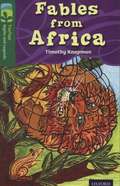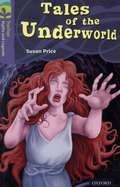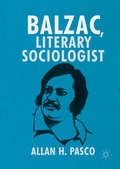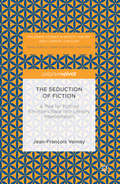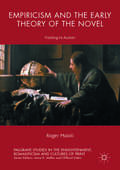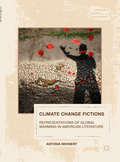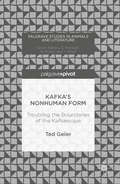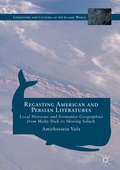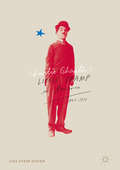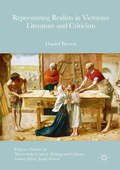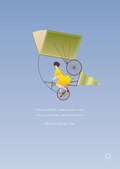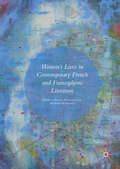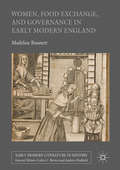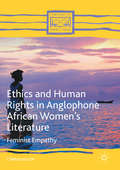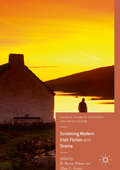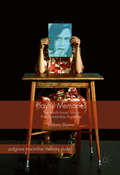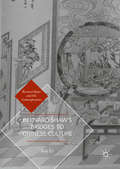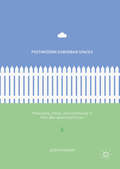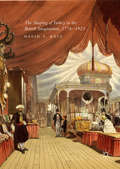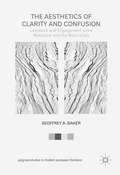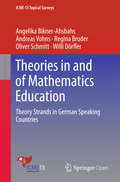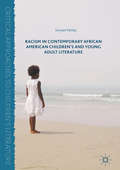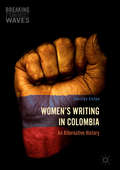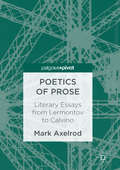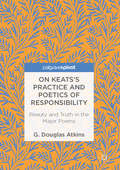- Table View
- List View
Oxford Reading Tree TreeTops Myths and Legends: Level 12: Fables From Africa (Oxford Reading Tree Ser.)
by Timothy KnapmanMeet a proud lion, a hungry hyena and a greedy lizard in Fables from Africa. These animals learn very important lessons in these stories from Africa which will make you both laugh and think. TreeTops Myths and Legends are a fascinating selection of the best traditional stories.
Oxford Reading Tree TreeTops Myths and Legends: Level 17: Tales Of The Underworld (Oxford Reading Tree Treetops Myths And Legends Ser.)
by Susan PriceTales of the Underworld are stories about loss and longing. A princess uses her wit to rescue her husband from Death, a musician tries to free his wife from the Underworld, a god must be returned to life and animals at the dawn of time puzzle over death. TreeTops Myths and Legends are a fascinating selection of the best traditional stories.
Balzac, Literary Sociologist
by Allan H. PascoMelding the fields of literature, sociology, and history, this book develops analyses of the ten novels in Balzac's Scènes de la vie de province. Following the order of the novels projected in La Comédie humaine, Allan H. Pasco investigates how Balzac used art as a tool of social inquiry to obtain startlingly accurate insights into the relationships that defined his turbulent society. His repeated claim to be an "historian of manners" was more than an empty boast. Though Balzac was first and foremost a great novelist, he was also a trailblazing sociologist, joining Henri de Saint-Simon and the subsequent Auguste Comte in considering the relationships that represent society as an interacting, interlocking web. Using a methodology that combines close analysis with a broad cultural context, Pasco demonstrates that Balzac's sociological vision was extraordinarily pertinent to both his and our days.
The Seduction of Fiction: A Plea for Putting Emotions Back into Literary Interpretation (Palgrave Studies in Affect Theory and Literary Criticism)
by Jean-François VernayBy meshing psychology with literary analysis, this book inspires us to view the reading of fictional works as an emotional and seductive affair between reader and writer. Arguing that current teaching practices have contributed to the current decline in the study of literature, Jean-François Vernay’s plea brings a refreshing perspective by seeking new directions and conceptual tools to highlight the value of literature. Interdisciplinary in focus and relevant to timely discussions of the vitality between emotion and literary studies, particularly within the contexts of psychology, affect studies, and cognitive studies, this book will open up a space in which the formation of our emotions can be openly examined and discussed.
Empiricism and the Early Theory of the Novel: Fielding to Austen (Palgrave Studies in the Enlightenment, Romanticism and Cultures of Print)
by Roger MaioliThis book is about the empiricist challenge to literature, and its influence on eighteenth-century theories of fiction. British empiricism from Bacon to Hume challenged the notion that imaginative literature can be a reliable source of knowledge. This book argues that theorists of the novel, from Henry Fielding to Jane Austen, recognized the force of the empiricist challenge but refused to capitulate. It traces how, in their reflections on the novel, these writers attempted to formulate a theoretical link between the world of experience and the products of the imagination, and thus update the old defenses of poetry for empirical times. Taken together, the empiricist challenge and the responses it elicited signaled a transition in the longstanding debate about literature and knowledge, as an inaugural round in the persisting conflict between the empirical sciences and the literary humanities.
Climate Change Fictions: Representations of Global Warming in American Literature (Literatures, Cultures, and the Environment)
by Antonia MehnertThis book highlights the importance of the cultural sphere, and in particular literature, in response and discussion with the unprecedented phenomenon known as climate change. Antonia Mehnert turns to a set of contemporary American works of fiction, reading them as a unique response to the challenges of representing climate change. She draws on “climate change fiction”— texts dealing explicitly with anthropogenic climate change—and explores how these works convey climate change, deal with its challenging characteristics, and with what narrative techniques they ultimately participate in its communication. Indeed, a number of challenging traits make climate change a difficult issue to engage with including its slow and long temporal dimension, global scale, scientific controversy, and its disconnect between cause and effect. Considering such complexity and uncertainty at the source of climate change fictions, this book moves beyond a solely ecocritical analysis and shows how these climate change fictions constitute an insightful cultural repertoire valuable for discussion in the environmental humanities in general.
Kafka’s Nonhuman Form: Troubling the Boundaries of the Kafkaesque (Palgrave Studies in Animals and Literature)
by Ted GeierThis book is a compact study of Kafka’s inimitable literary style, animals, and ecological thought—his nonhuman form—that proceeds through original close readings of Kafka’s oeuvre. With select engagements of Adorno, Derrida, and the literary heritage from Romanticism to Dickens that influenced Kafka, Ted Geier discusses Kafka’s literary, “nonhuman” form and the way it unsettles the notion of a natural and simple existence that society and culture impose, including the boundaries between human and animal. Through careful attention to the formal predicaments of Kafka’s works and engaging with Kafka’s original legal and social thought in his novels and short stories, this book renders Kafka’s sometimes impossibly enigmatic work legible at the level of its expression, bringing surprising shape to his work and redefining what scholars and readers have understood as the “Kafkaesque”.
Recasting American and Persian Literatures: Local Histories and Formative Geographies from Moby-Dick to Missing Soluch (Literatures and Cultures of the Islamic World)
by Amirhossein VafaReading literary and cinematic events between and beyond American and Persian literatures, this book questions the dominant geography of the East-West divide, which charts the global circulation of texts as World Literature. Beyond the limits of national literary historiography, and neocolonial cartography of world literary discourse, the minor character Parsee Fedallah in Herman Melville’s Moby-Dick (1851) is a messenger who travels from the margins of the American literature canon to his Persian literary counterparts in contemporary Iranian fiction and film, above all, the rural woman Mergan in Mahmoud Dowlatabadi’s novel Missing Soluch (1980). In contention with Eurocentric treatments of world literatures, and in recognition of efforts to recast the worldliness of American and Persian literatures, this book maintains that aesthetic properties are embedded in their local histories and formative geographies.
Charlie Chaplin’s Little Tramp in America, 1947–77
by Lisa Stein HavenThis book focuses on the re-invigoration of Charlie Chaplin’s Little Tramp persona in America from the point at which Chaplin reached the acme of his disfavor in the States, promoted by the media, through his departure from America forever in 1952, and ending with his death in Switzerland in 1977. By considering factions of America as diverse as 8mm film collectors, Beat poets and writers and readers of Chaplin biographies, this cultural study determines conclusively that Chaplin’s Little Tramp never died, but in fact experienced a resurgence, which began slowly even before 1950 and was wholly in effect by 1965 and then confirmed by 1972, the year in which Chaplin returned to the United States for the final time, to receive accolades in both New York and Los Angeles, where he received an Oscar for a lifetime of achievement in film.
Representing Realists in Victorian Literature and Criticism (Palgrave Studies in Nineteenth-Century Writing and Culture)
by Daniel BrownThis book is about the historical moment when writers and critics first used the term “realism” to describe representation in literature and painting. While scholarship on realism tends to proceed from an assumption that the term has a long-established meaning and history, this book reveals that mid-nineteenth-century critics and writers first used the term reluctantly, with much confusion over what it might actually mean. It did not acquire the ready meaning we now take for granted until the end of the nineteenth century. In fact, its first definitions came primarily by way of example and analogy, through descriptions of current practitioners, or through fictionalized representations of artists. By investigating original debates over the term “realism,” this book shows how writers simultaneously engaged with broader concerns about the changing meanings of what was real and who had the authority to decide this.
Philosophy, Dreaming and the Literary Imagination
by Michaela Schrage-FrühThis book explores the intersections between dreaming and the literary imagination, in light of the findings of recent neurocognitive and empirical research, with the aim to lay a groundwork for an empirically informed aesthetics of dreaming. Drawing on perspectives from literary theory, philosophy of mind and dream research, this study investigates dreaming in relation to creativity and waking states of imagination such as writing and reading stories. Exploring the similarities and differences between the 'language' of dreams and the language of literature, it analyses the strategies employed by writers to create a sense of dream in literary fiction as well as the genres most conducive to this endeavour. The book closes with three case studies focusing on texts by Kazuo Ishiguro, Clare Boylan and John Banville to illustrate the diverse ways in which writers achieve to 'translate' the experience and 'language' of the dream.
Women’s Lives in Contemporary French and Francophone Literature
by Florence Ramond Jurney Karen McPhersonThe essays in this volume provide an overview and critical account of prevalent trends and theoretical arguments informing current investigations into literary treatments of motherhood and aging. They explore how two key stages in women’s lives—maternity and old age—are narrated and defined in fictions and autobiographical writings by contemporary French and francophone women. Through close readings of Maryse Condé, Hélène Cixous, Zahia Rahmani, Linda Lê, Pierrette Fleutieux, and Michèle Sarde, among others, these essays examine related topics such as dispossession, female friendship, and women’s relationships with their mothers. By adopting a broad, synthetic approach to these two distinct and defining stages in women’s lives, this volume elucidates how these significant transitional moments set the stage for women’s evolving definitions (and interrogations) of their identities and roles.
Women, Food Exchange, and Governance in Early Modern England (Early Modern Literature in History)
by Madeline BassnettThis book is about the relationship of food and food practices to discourses and depictions of domestic and political governance in early modern women’s writing. It examines the texts of four elite women spanning approximately forty years: the Psalmes of Mary Sidney Herbert, Countess of Pembroke; the maternal nursing pamphlet of Elizabeth Clinton, Dowager Countess of Lincoln; the diary of Margaret, Lady Hoby; and Mary Sidney, Lady Wroth’s prose romance, Urania. It argues that we cannot gain a full picture of what food meant to the early modern English without looking at the works of women, who were the primary managers of household foodways. In examining food practices such as hospitality, gift exchange, and charity, this monograph demonstrates that women, no less than men, engaged with vital social, cultural and political processes.
Ethics and Human Rights in Anglophone African Women’s Literature: Feminist Empathy (Comparative Feminist Studies)
by Chielozona EzeThis book proposes feminist empathy as a model of interpretation in the works of contemporary Anglophone African women writers. The African woman’s body is often portrayed as having been disabled by the patriarchal and sexist structures of society. Returning to their bodies as a point of reference, rather than the postcolonial ideology of empire, contemporaryAfrican women writers demand fairness and equality. By showing how this literature deploys imaginative shifts in perspective with women experiencing unfairness, injustice, or oppression because of their gender, Chielozona Eze argues that by considering feminist empathy, discussions open up about how this literature directly addresses the systems that put them in disadvantaged positions. This book, therefore, engages a new ethical and human rights awareness in African literary and cultural discourses, highlighting the openness to reality that is compatible with African multi-ethnic, multi-racial, and increasingly cosmopolitan communities.
Screening Modern Irish Fiction and Drama (Palgrave Studies in Adaptation and Visual Culture)
by R. Barton Palmer Marc C. ConnerThis book offers the first comprehensive discussion of the relationship between Modern Irish Literature and the Irish cinema, with twelve chapters written by experts in the field that deal with principal films, authors, and directors. This survey outlines the influence of screen adaptation of important texts from the national literature on the construction of an Irish cinema, many of whose films because of cultural constraints were produced and exhibited outside the country until very recently. Authors discussed include George Bernard Shaw, Oscar Wilde, Liam O’Flaherty, Christy Brown, Edna O’Brien, James Joyce, and Brian Friel. The films analysed in this volume include THE QUIET MAN, THE INFORMER, MAJOR BARBARA, THE GIRL WITH GREEN EYES, MY LEFT FOOT, THE PICTURE OF DORIAN GRAY, THE SNAPPER, and DANCING AT LUGHNASA. The introduction features a detailed discussion of the cultural and political questions raised by the promotion of forms of national identity by Ireland’s literary and cinematic establishments.
Playful Memories: The Autofictional Turn in Post-Dictatorship Argentina (Palgrave Macmillan Memory Studies)
by Jordana BlejmarThis volume examines the blending of fact and fiction in a series of cultural artefacts by post-dictatorship writers and artists in Argentina, many of them children of disappeared or persecuted parents. Jordana Blejmar argues that these works, which emerged after the turn of the millennium, pay testament to a new cultural formation of memory characterised by the use of autofiction and playful aesthetics. She focuses on a range of practitioners, including Laura Alcoba, Lola Arias, Félix Bruzzone, Albertina Carri, María Giuffra, Victoria Grigera Dupuy, Mariana Eva Perez, Lucila Quieto, and Ernesto Semán, who look towards each other's works across boundaries of genre and register as part of the way they address the legacies of the 1976-1983 dictatorship. Approaching these works not as second-hand or adoptive memories but as memories in their own right, Blejmar invites us to recognise the subversive power of self-figuration, play and humour when dealing with trauma.
Bernard Shaw’s Bridges to Chinese Culture (Bernard Shaw and His Contemporaries)
by Kay LiThis book explores the cultural bridges connecting George Bernard Shaw and his contemporaries, such as Charles Dickens and Arthur Miller, to China. Analyzing readings, adaptations, and connections of Shaw in China through the lens of Chinese culture, Li details the negotiations between the focused and culturally specific standpoints of eastern and western culture while also investigating the simultaneously diffused, multi-focal, and comprehensive perspectives that create strategic moments that favor cross-cultural readings.With sources ranging from Shaw's connections with his contemporaries in China to contemporary Chinese films and interpretations of Shaw in the digital space, Li relates the global impact of not only what Chinese lenses can reveal about Shaw's world, but how intercultural and interdisciplinary readings can shed new light on familiar and obscure works alike.
Postmodern Suburban Spaces: Philosophy, Ethics, and Community in Post-War American Fiction
by Joseph GeorgeThis book reevaluates fiction devoted to the postwar American suburb, examining the way these works imagine suburbia as a communal structure designed to advance a particular American identity. Postmodern Suburban Spaces surveys works by both canonical chroniclers of the middle class experience, such as Richard Yates and John Cheever, and those who reflect suburbia’s demographic reality, including Gloria Naylor and Chang-rae Lee, to uncover a surprising reconfiguration of the suburban experience. Tracing major forms of suburban associations – racial divisions, property lines, the family, and ethnic fealty – these works depict a different mode of interaction than the stereotypical white picket fences. Joseph George draws from philosophers such as Emmanuel Levinas and Roberto Esposito to argue that these fictions assert a critical hospitality that frustrates the limited forms of association on which suburbia is based. This fiction, in turn, posits an ethical form of community that comes about when people share space together.
The Shaping of Turkey in the British Imagination, 1776–1923
by David S. KatzThis book is about the principal writings that shaped the perception of Turkey for informed readers in English, from Edward Gibbon’s positing of imperial Decline and Fall to the proclamation of the Turkish Republic (1923), illustrating how Turkey has always been a part of the modern British and European experience. It is a great sweep of a story: from Gibbon as standard textbook, through Lord Bryon the pro-Turkish poet, and Benjamin Disraeli the Romantic novelist of all things Eastern, followed by John Buchan's Greenmantle First World War espionage fantasies, and then Manchester Guardian reporter Arnold Toynbee narrating the fight for Turkish independence.
The Aesthetics of Clarity and Confusion: Literature and Engagement since Nietzsche and the Naturalists (Palgrave Studies in Modern European Literature)
by Geoffrey A. BakerWhat should literature with political aims look like? This book traces two rival responses to this question, one prizing clarity and the other confusion, which have dominated political aesthetics since the late nineteenth century. Revisiting recurrences of the avant-garde experimentalism versus critical realism debates from the twentieth century, Geoffrey A. Baker highlights the often violent reductions at work in earlier debates. Instead of prizing one approach over the other, as many participants in those debates have done, Baker focuses on the manner in which the debate itself between these approaches continues to prove productive and enabling for politically engaged writers. This book thus offers a way beyond the simplistic polarity of realism vs. anti-realism in a study that is focused on influential strands of thought in England, France, and Germany and that covers well-known authors such as Zola, Nietzsche, Arnold, Mann, Brecht, Sartre, Adorno, Lukács, Beauvoir, Morrison, and Coetzee.
Theories in and of Mathematics Education: Theory Strands in German Speaking Countries (ICME-13 Topical Surveys)
by Angelika Bikner-Ahsbahs Andreas Vohns Oliver Schmitt Regina Bruder Willi DörflerThis survey provides an overview of German meta-discourse on theories and mathematics education as a scientific discipline, from the 1970s to the 1990s. Two theory strands are offered: a semiotic view related to Peirce and Wittgenstein (presented by Willibald Dörfler), and the theory of learning activity by Joachim Lompscher (presented by Regina Bruder and Oliver Schmitt). By networking the two theoretical approaches in a case study of learning fractions, it clarifies the nature of the two theories, how they can be related to inform practice and renew TME-issues for mathematics education as a scientific discipline. Hans-Georg Steiner initiated the first of five international conferences on Theories of Mathematics Education (TME) to advance the founding of mathematics education as a scientific discipline, and subsequently German researchers have continued to focus on TME topics but within various theory strands.
Racism in Contemporary African American Children’s and Young Adult Literature (Critical Approaches to Children's Literature)
by Suriyan PanlayApplying critical race theory to contemporary African American children’s and young adult literature, this book explores one key racial issue that has been overlooked both in race studies and literary scholarship—internalised racism. By systematically examining the issue of internalised racism and its detrimental psychological effects, particularly towards the young and vulnerable, this book defamiliarises the very racial issue that otherwise has become normalised in American racial discourse, reaffirming the relevance of race, racism, and racialisation in contemporary America. Through readings of works by Jacqueline Woodson, Sharon G. Flake, Tanita S. Davis, Sapphire, Rosa Guy, and Nikki Grimes, Suriyan Panlay develops a new critical discourse on internalised racism by studying its effects on marginalised children, its manifestations, and the fictional narrative strategies that can be used to regain and reclaim a sense of self.
Women's Writing in Colombia: An Alternative History (Breaking Feminist Waves)
by Cherilyn ElstonWinner of the Montserrat Ordóñez Prize 2018This book provides an original and exciting analysis of Colombian women’s writing and its relationship to feminist history from the 1970s to the present. In a period in which questions surrounding women and gender are often sidelined in the academic arena, it argues that feminism has been an important and intrinsic part of contemporary Colombian history. Focusing on understudied literary and non-literary texts written by Colombian women, it traces the particularities of Colombian feminism, showing how it has been closely entwined with left-wing politics and the country’s history of violence. This book therefore rethinks the place of feminism in Latin American history and its relationship to feminisms elsewhere, challenging many of the predominant critical paradigms used to understand Latin American literature and culture.
Poetics of Prose: Literary Essays from Lermontov to Calvino
by Mark AxelrodThis creative yet scholarly book discusses prose's important relationship to close literary analysis, showing how such an approach can be beneficial for readers, scholars, and writers alike. Bringing together a literary history that consists of writers such as Lermontov, Chekhov, Camus, and Calvino, Mark Axelrod masterfully interweaves discussions of structure, context, genre, plot, and other key elements often applied to poetry but seldom applied to various forms of prose in order to offer bold and surprisingly fresh claims about the writer's purpose. By peeling back these layers of technique and style, this book opens up discussions to better understand and appreciate great dramatists, writers, and poets throughout time by returning back to the core elements that originally comprised their writing crafts.
On Keats’s Practice and Poetics of Responsibility: Beauty and Truth in the Major Poems
by G. Douglas AtkinsThis accessible, informed, and engaging book offers fresh, new avenues into Keats’s poems and letters, including a valuable introduction to “the responsible poet.” Focusing on Keats’s sense of responsibility to truth, poetry, and the reader, G. Douglas Atkins, a noted T.S. Eliot critic, writes as an ama-teur. He reads the letters as literary texts, essayistic and dramatic; the Odes in comparison with Eliot’s treatment of similar subjects; “The Eve of St. Agnes” by adding to his respected earlier article on the poem an addendum outlining a bold new reading; “Lamia” by focusing on its complex and perplexing treatment of philosophy and imagination and revealing how Keats literally represents philosophy as functioning within poetry. Comparing Keats with Eliot, poet-philosopher, this book generates valuable insight into Keats’s successful and often sophisticated poetic treatment of ideas, accentuating the image of him as “the responsible poet.”
